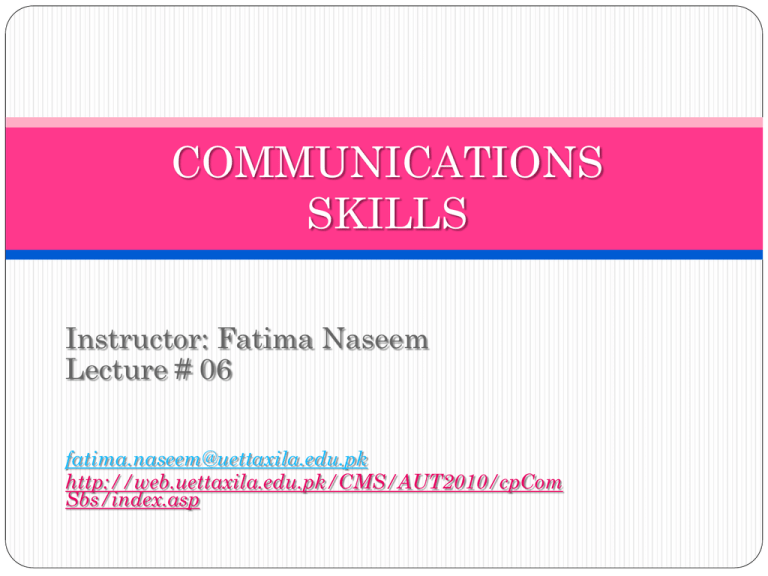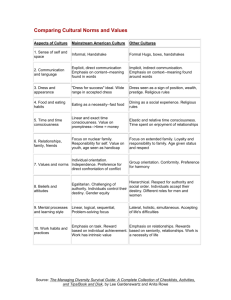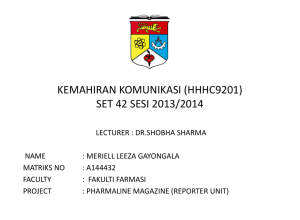COMMUNICATIONS SKILLS
advertisement

COMMUNICATIONS SKILLS Instructor: Fatima Naseem Lecture # 06 fatima.naseem@uettaxila.edu.pk http://web.uettaxila.edu.pk/CMS/AUT2010/cpCom Sbs/index.asp Chapter # 03 Business Communication and the Global Context Overview Background to Inter-cultural Communication National cultural Variables Individual Cultural variables Education Time Law and Regulations Space Economics Food Politics Acceptable dress Religion Manners Social Norms Decision making Language Verbal and Non- Verbal Communication Background to Inter-cultural Communication Globalization: the process of increasing the connectivity and interdependence of the world's markets and businesses. Therefore understanding others culture is very important You should also be familiar with your own ethnic diversity An Intercultural Communication Model We are more comfortable with familiar people Basic human characteristics are common to all For a Doctor, working of a human body is same in America and Malaysia Acts of walking, love for family, shaking hands Core cultural values are close to being fixed Learning the differences in moral and ethical concepts of different ethnic groups is important Cultural Overlap Cultural Similarities and Dissimilarities National Cultural Variables National Cultural Variables These are the MACRO or global constraints Education Law and Regulations Economics Politics Religion Social Norms Language See Checklist 3.1 Education You should be aware of the education level of the person you are speaking to. Management education is more prevalent in U.S. Some countries have no academic courses in communication training E.g. China Go beyond your initial inferences and assumptions before concluding anything Education Levels of Chinese, Asian and U.S Mangers Highest level of education Chinese % Asian % U.S % Less than high school 5.4 2.5 0.1 High school graduate 31.8 12.4 3.2 Some college 34.6 19.4 16.9 Undergraduate degree 27.6 65.4 79.8 Post graduate degree 0.7 25.0 30.0 Law and Regulations You and your legal department must be aware of the law matters internationally In both the under-developed and developed nations, various government regulations affect business communications and sale of products. Examples: Advertising children is restricted in U.S, Canada, Scandinavian states. “Cigarette” is restricted in Europe France, Mexico and Province of Quebec have restriction on the use of foreign languages in advertisements. Guidelines: Are the laws acceptable and enforced? To what extent are the laws codify? Is there uniform enforcement of law? Economics Availability of capital and transportation and the standard of living per capita vary from nation to nation. The opportunity to borrow money, the rate of inflation (price raise), and the exchange rates influence business and a country’s ability to communicate concerning that business. For example in Pakistan the competitors usually set their own prices. In contrast IEEE set their own standards for different computer equipments Guidelines: Which economic changes have occurred in the past 5 years? How supportive is the government for outside investors and joint ventures? Will the funds be easily removed from your host country? Politics Politics also effect our communication when we are doing business which can even result in personal harm. Even concepts of democracy vary in different countries There are different indices of measuring political instability in any country Have a pre knowledge of it. Guidelines: Which political changes have occurred in the past 5 years? How supportive is the government for outside investors and joint ventures? What protocols must individuals follow in the host country? Religion Homogeneity and diversity of belief structure Religion in different areas of the world can effect the business and communications. Some basic beliefs may be same but different religions have major differences which, if not understood well can lead to great loss. In U.S Muslims, Protestants, Catholic, Hindu, Buddhist live. Great tolerance is required Recent statistics have shown some religions have totally changed the style of business and even the structure of that specific country. Consumption of alcohol Holidays Status of women Guidelines: Are you aware of major religions Are you aware of holidays What personal behavior is acceptable and what is not. Social Norms Importance of family, influence of past colonial influences In various ways national environmental constraints, education, law and regulations, economics, politics and religion effect a nation’s social norms. In most of the countries Male line of family takes family decisions. Beyond family, bond may exist between persons, based on caste, class, age Guidelines Are you aware of the hierarchy of the country Is there a rank order of importance for participants of the meeting Who will actually make the business decisions Language Every body knows that knowing the language of your country is the most significant contribute to improved communication, on personal and business level. Your communication is good when both sender and receiver have same language. English is world language. Young people mostly are able to speak and understand English but few are the old people Guidelines: Is it necessary to have an interpreter? Is English understood at written or oral level? Is there a formal/ informal protocol to follow for business communication? Individual Cultural variables Individual Cultural variables On the micro or personal level each individual exhibits own habits and behavior. Time Space Food Acceptable dress Manners Decision making Verbal and Non-Verbal Communication See checklist 3.2 Time Time is also factor in communication. Germans are time-precise; rarely do you wait for an appointment in Germany. Specify exact opening and closing time for business In Latin America and Buddhist cultures-waiting is acceptable, same is the example here in Pakistan. Referring to seasons of the year differ; some say winter, spring, etc; some say dry, rainy. Some cultures are casual some are precise about time, like we’ll talk at 8:15 am tomorrow, some say we’ll talk some time tomorrow. Sometimes delays due to lack of equipment Guidelines: Is time considered linear or circular? What is impact of time on business? Is time valuable or intangible asset? Space How close may stranger stand to you? Americans want more space, less do Arabs and Latin Americans Room spaces also differ. Make sure what is the average acceptable space between the natives of your host country Food Eating habits are different throughout the world Depends on religion, agriculture and climatic conditions What table conventions should be followed? Which foods are disagreeable? Acceptable dress Dress also has value in communication. When u have good dress then sound will be clear. So its very important when you are communication in front of gathering, your dress should be perfect. Check if any colors are disturbing? Will western attire be accepted? Manners See children to know manners of elders They shake hand in Germany, hug in Italy, and stay in background in India You bring a gift when visiting most homes in Europe If you bring flowers, avoid Red Roses in Germany and white chrysanthemum in France, Belgium and Japan. 2-3 hours lunch in Europe is acceptable. Many people sit on single table to eat in Asia In Saudi Arabia, you will learn that the junior prince is silent when a senior enters. See for introduction manner in business environment Rules of gift giving Decision making Patience above all is needed in intercultural communication, in doing business with other countries. American are typecast as moving too quickly in asking for a decision. Americans are accused of (blame) being quick; “we wish to get to the point fast.” When one reaches Japan, decision time is held back as group consensus moves toward a decision. As you can imagine much time is spent in reaching an answer. Thus patience-and your understanding of the decision process-add to your success in dealing with a foreign environment. Verbal and Non-Verbal Communication Verbal: Regardless of culture, a kind of verbal communication occurs when strangers meet, each seeking to determine which topics are acceptable and non-controversial (not in). Additionally, tone of voice of one’s initial words can influence your initial perception of whether the meeting is positive or negative. We judge people to a great extent by their voice. Some native languages demand many tonal variations, giving the impression to a non-native of loudness, even arrogance. “see you later” means same day sometime for Asians and some indefinite time for Americans. “Yes” for Asian may mean a yes or a no Be sure about the volume, pitch and rate of voice See check list 3.3 from book Non- Verbal: Many nonverbal symbols exists for every culture, even in subcultures. Knowing the major desirable and undesirable cues (signs) helps knowing both intended and unintended communication errors. for example A handshake is a traditional form of greeting in the west. See checklist 3.4 Class Participation Draw a daisy wheel diagram showing the cultural overlap where country I & II has major overlap, III & IV have some overlap, while V only shares the basic characteristics and does not share any macro or micro level variables. QUIZ # 02 You are given a topic “Importance of Communication Skills ”. You have to present the topic in form of a power point presentation in front of 75 students of Electrical engineering. You are given some documents/ papers explaining the topic. How will you prepare the presentation keeping all the steps of preparing an oral presentation in mind. Any Questions ?








